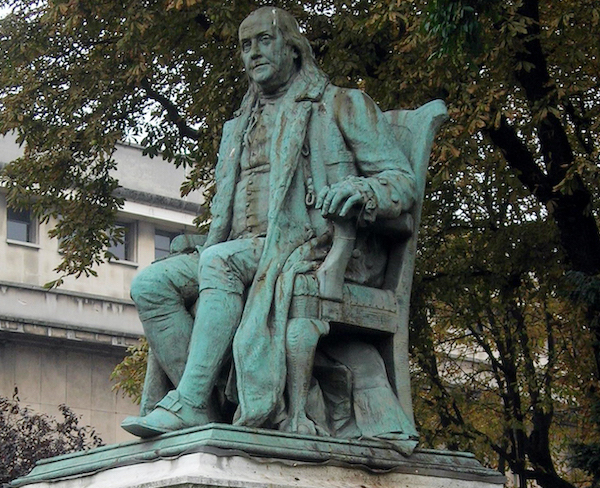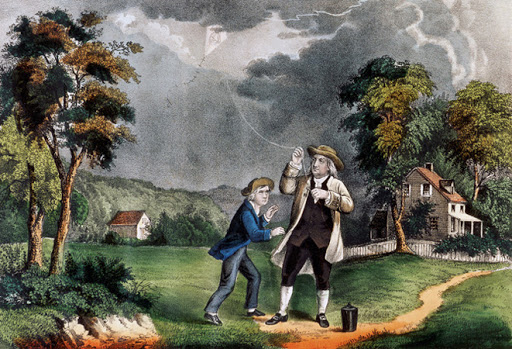10 Fun Facts About Benjamin Franklin
1. As a youth, Benjamin Franklin demonstrated exceptional swimming prowess. On his first trip abroad to London at the age of 19, he impressed his newly found friends by swimming 3.5 miles down the Thames River while they followed in their boat. He even undertook various water tricks along the way to entertain them. In 1968, Franklin became an honorary member of the International Swimming Hall of Fame in Fort Lauderdale, Flo., by virtue of his technique as well as his invention of the earliest hand paddles.
2. Slave ownership was ubiquitous in the colonies up until 1776, when slaves comprised about 20 percent of the overall population. For those like Franklin who lived in larger cities such as Philadelphia, slaves mainly worked as house servants. Franklin and his wife, Deborah Read, bought their first two slaves, Jemima and Peter, in the 1740s. They purchased three more, Othello, George and King, a few years later. However, in his later life, Franklin's view on slavery changed. In a letter he wrote to the London Chronicle in 1772, Franklin challenged whether slavery was a moral practice. However, he did not free his own slaves during his lifetime.
3. Although he only had two years of formal schooling, Benjamin Franklin spoke four languages: English, French, Spanish and Italian. He could also read and write Latin. He even invented a new English alphabet based on the Latin alphabet, eliminating redundant letters c, j, q, w, x, and y. He added his own letters and phonetic symbols to help with pronunciation. However, Franklin eventually abandoned his alphabet when it failed to attract much notice.
4. In a shady patch of Paris, at 38 Rue Benjamin Franklin, a copper statue of the founding father sits atop a pedestal that commemorates Franklin's time spent in the capital city of France. He is seated comfortably in an armchair, wearing his signature frock coat. Franklin was a celebrated visitor during his time in Paris, both as an ambassador from the United States and as a scientist. When Franklin died, the French observed a day of mourning.

5. The founding father was a vegetarian. When he was 16 years old, he read a book by Englishman Thomas Tryon recommending a meat-free diet. Franklin decided to try it, and he was pleased, not only with the money he saved on food but also with the clear-headedness he attributed to his new meatless regime. He remained a vegetarian for the rest of his life, although he allowed himself lapses from time to time.
6. Franklin died in 1790. Historians believe the cause of death was a lung infection leading to empyema, a buildup of pus in the lining of the lungs. The pus, or abscess, presses on the lungs, causing breathing difficulty and in Franklin's case, eventual death.
7. As a writer of letters, newspaper articles and books, Franklin hid behind a litany of pen names, both male and female. The most well-known are Richard Saunders of Poor Richard's Almanack and Silence Dogood, who wrote letters to James Franklin's newspaper. Other pseudonyms Franklin used include: Miss Polly Baker, Martha Careful, Caelia Shortface, Margaret Aftercast, Anthony Afterwit, Busy Body, Patience and Alice Addertongue. Franklin was following a literary tradition established by the authors he read such as Daniel Defoe, but the names he chose were usually tongue-in-cheek, in keeping with Franklin's unique brand of wit.
8. Although history credits Benjamin Franklin with discovering electricity, he was actually not the first to test the theory that lightning was an electric charge. He did come up with the hypothesis that the two were one in the same, which inspired French scientist Thomas-Francois Dalibard to attempt drawing electricity from a thunderhead. Franklin's kite experiment came a month later. Both scientists came to the same conclusion that Franklin's hypothesis was right.

9. Franklin followed up his kite flying experiment with other inquiries into the nature and uses of electricity. He had to come up with a vocabulary to describe his findings. He coined several terms still in use today, such as lightning rod, positive and negative charges, battery, conductor, condenser and armature.
10. Benjamin Franklin was an advocate for paper money during his lifetime when coins were the norm. He wrote letters, essays and pamphlets promoting the cause of paper money. He even designed and printed money for individual colonies during the Revolutionary War. At the 1787 Continental Congress, which Franklin attended, members of the new federal government took the power to issue currency from the states so they could print money that was good throughout the country. Fittingly, Franklin's likeness now graces the U.S. $100 bill.
